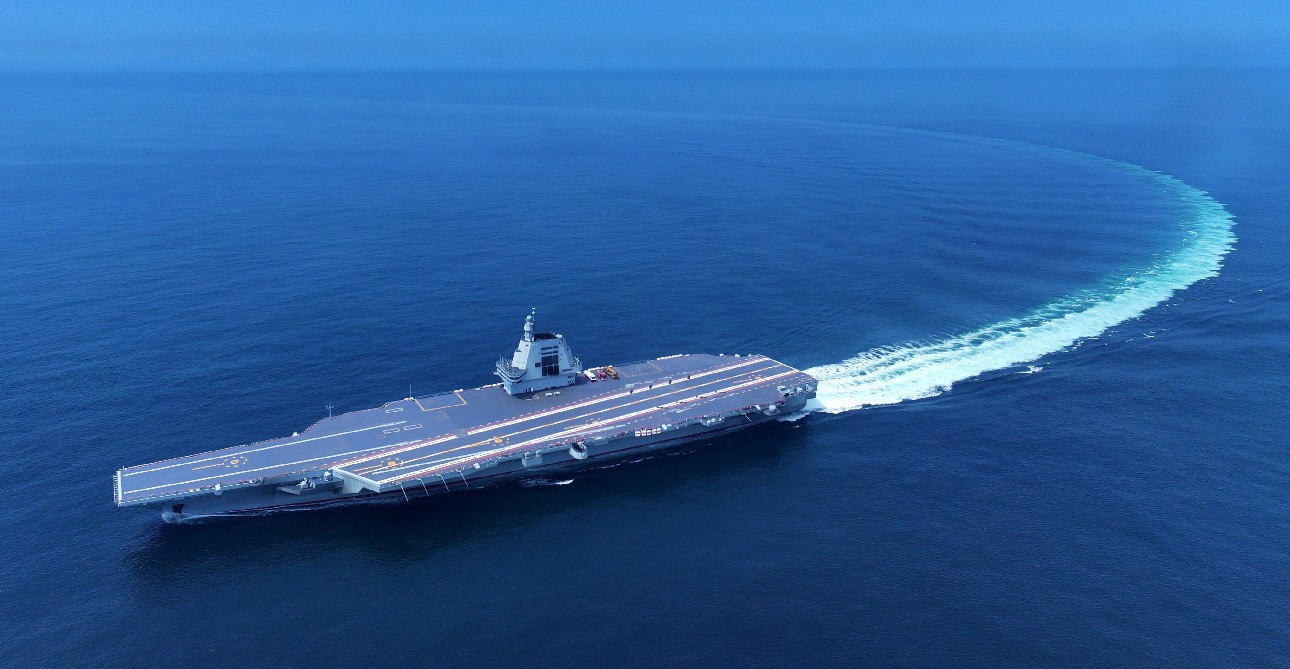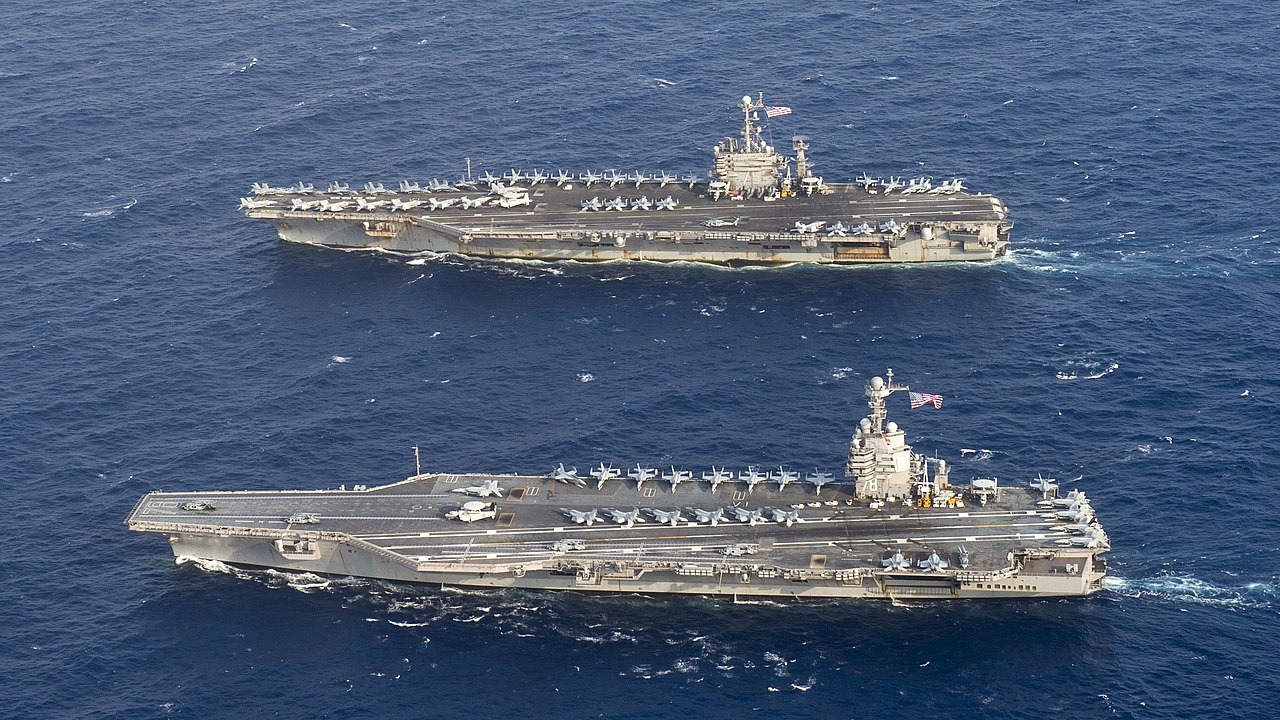As the People’s Liberation Army Navy (PLAN) pushes ahead with massive expansion, the construction of the much more advanced 4th Chinese aircraft carrier has reportedly started.
This will give a big maritime power boost as it adds to the expanding fleet of destroyers, frigates, conventional and nuclear submarines, and assault ships.
Considering that the first Chinese aircraft carrier “Liaoning” (Type 001), a locally refurbished Ukrainian carrier, became combat-ready and only entered service in 2016, less than 9 years ago, it is a big achievement.
The second fully home-grown carrier, “Shandong” (Type 002), was launched in April 2017. The third aircraft carrier, the “Fujian” (Type 003), was launched in June 2022 and should very soon begin its sea trials, with a probable entry into service in 2025.
There is clearly visible momentum towards the stated goal of having six operational aircraft carriers by 2035. But surely, there are technological challenges. It is important to understand the evolution of the PLAN carriers and their relative status.
PLAN Operational Aircraft Carriers
In 1985, China began acquiring four retired aircraft carriers, the British-built Australian HMAS Melbourne and the ex-Soviet carriers Minsk, Kiev, and Varyag, for initial study. The Varyag later underwent an extensive refit to be converted into the Liaoning, China’s first operational aircraft carrier, which also served as a basis for China’s subsequent design iterations.
Interestingly, India had thought much ahead and acquired the British HMS Hercules in 1957. It had completed refurbishment and operationalized as INS Vikrant by 1961, albeit it was a small carrier (16,000 tons). Yet, it played a significant operational role in the 1971 Indo-Pak war.
The 67,500-ton ex-Soviet aircraft carrier Varyag (Kuznetsov class), which was 68% complete and floating in Ukraine, was purchased in 1988 and towed to China. It underwent hull work at Mykolaiv Shipyard and refit at Dalian Shipyard.
Later named “Liaoning,” it was commissioned in September 2012 and began sea trials. In November 2012, the first landing was successfully conducted on Liaoning with Shenyang J-15, albeit with partial fuel to reduce weight. It became combat-ready in 2016. The carrier operates from Yuchi Naval Base.
China’s second carrier, the 70,000-ton “Shandong (Type 002), is the first domestically built. Similar to Liaoning, it uses conventional steam turbines with diesel generators as propulsion and ski-jump for take-off.
The improvements over Liaoning included the ski-jump angle reduced from 14 degrees to 12 degrees for easier launching of the Shenyang J-15 fighter. The hangar is enlarged. Deck space has been freed to allow up to eight more aircraft and helicopters to be carried.
It also features four active electronically scanned arrays (AESAs) for the S-band Type 346 radar. Construction began in November 2013 at the Dalian Shipyard, and the ship was launched on 26 April 2017.
It underwent nine sea trials over 18 months, starting May 2018. The ship was formally commissioned into service on 19 December 2019. Its home port is Yulin Naval Base. It achieved initial operating capability (IOC) in October 2020, which is the basic standard for deployment. Effectively, the carrier became operational nearly seven years after construction began.
Meanwhile, India’s 45,000-ton INS “Vikrant” work began in 1999. The keel was laid in 2009. The carrier was floated out of dry dock in December 2011 and launched in August 2013. Basin trials were completed in December 2020, and it was commissioned on 02 September 2022.
Aircraft Carrier “Fujian” Type 003
China’s third aircraft carrier, the 80,000-ton Fujian, is being built by the Jiangnan Shipyard. It is slightly smaller in size than the US Navy’s Ford Class ships. Construction started in February 2017. It was launched on June 17, 2022, and is currently being fitted out.
It is China’s first Catapult-Assist Take-off Barrier-Arrested Recovery (CATOBAR) aircraft carrier, with an integrated propulsion system and three electromagnetic catapults. In January 2024, the Fujian was conducting mooring tests in preparation for its maiden voyage.

Type 004 Super-Carrier
The, still to be named 110,000-ton super-carrier Type 004 is planned to be larger than Type 003 and also feature nuclear propulsion, an integrated electric system that will allow the operation of electromagnetic catapults, and support laser weapons and rail guns.
Construction reportedly started in December 2017 at Jiangnan Shipyard. The development of two prototype molten salt nuclear reactors cost $3.3 billion. The carrier is planned to operate a complement of J-15 and J-31 5th-generation fighters, Xian KJ-600 airborne early warning and control aircraft, anti-submarine warfare aircraft, and stealth attack drones.
The much larger J-20 5th-Genfighter, which is structurally not designed for carrier operations, is presently unlikely to be used. Additionally, it does not have folding wings for compact storage, and its stealth coating would be susceptible to degradation while at sea.
Development Of Carrier-Based Aircraft
In the early 2000s, China wanted to acquire Russian Sukhoi Su-33 carrier-based aircraft. Later, in 2006, they reverse-engineered, and the Shenyang J-15, featuring Chinese technology and avionics from the J-11B program, evolved. In November 2012, it was announced that at least two Shenyang J-15s had successfully landed on Liaoning. But the J-15 cannot take off from Liaoning with full fuel and munitions and is restricted to a max payload of 12 tons.
The stealth Shenyang J-31 is an in-development medium-sized (25-28 ton, same as Indian AMCA), fifth-generation stealth fighter that has a naval variant with folding wings and a catapult bar for carrier operations.
J-31 is rather similar to F-22, albeit smaller. It is also much smaller than the Chengdu J-20. By June 2020, three test aircraft were flying. J-31 incorporates certain stealth characteristics, such as forward-swept intake ramps with diverterless supersonic inlet (DSI) bumps, a two-piece bubble canopy, contoured weapon bays, and two oblique vertical stabilizers.
The J-31 can carry an 8-ton payload and has two internal weapons bays that can each carry two medium-range missiles, along with two heavy hard points and one light hard point on each wing. Some in the US believe that the Chinese had penetrated the database of the Joint Strike Fighter program and acquired terabytes of secret information.
The J-31’s avionics and weapon carriage remain inferior to those of the American F-35. Currently using the Guizhou WS-13 (RD-93 class) engine, China is working on an improved variant named WS-13E with 100 kN thrust for use on the J-31. Later, a Guizhou WS-19 turbofan engine, which has a maximum of 117.7 kN, is planned. The export variant is being called J-35. At a ceremony in January 2024, Pakistan announced its intent to acquire the J-31 aircraft.
The Xi’an KJ-600 is an in-development high-straight wing AEW&C aircraft suspected to be fitted with an AESA-type radome system. The non-flying mock-up model has a striking external resemblance to the aft-folding Northrop Grumman E-2 Hawkeye carrier-based AEW&C aircraft.
The design is somewhat similar to the canceled Soviet Yak-44 aircraft, which itself was an E-2 look alike. The KJ-600 would be a massive boost to the Chinese Navy.
PLAN also operates a significant number of Changhe Z-18 and Russian Kamov Ka-31 AEW helicopters, as well as many Russian and Chinese anti-submarine warfare helicopters. It also has a few land-based Xian H-6 aerial flight refuellers in its inventory.
Global Aircraft Carriers
During World War I, the British Navy developed the first true aircraft carrier with an unobstructed flight deck, the HMS Argus, which was built on a converted merchant ship hull. A Japanese carrier, the Hosyo, which entered service in December 1922, was the first carrier designed as such from the keel up.
The first aircraft carrier commissioned into the United States Navy (USN) was the USS Langley (CV-1) on 20 March 1922. By World War II, they had close to 35 carriers. During the Cold War, supercarriers were built. Enterprise (CVN-65) was the first nuclear-powered carrier, and John F. Kennedy (CV-67) was the last conventionally powered carrier.
These were then followed by the Nimitz class and the modern-day post-Cold War Gerald R. Ford-class nuclear supercarriers, the only two classes of supercarriers currently in active duty service. Today, they have 11 supercarriers.
Three are under fitting or construction, and one more has just been ordered. Typically, a supercarrier is nuclear powered, and the USS Gerald R. Ford, the world’s largest aircraft carrier, has over 100,000 tons displacement, 25 decks, and could carry around 80 aircraft.
The total US combined deck space is over twice that of all other nations combined. The USN also has nine amphibious assault ships, which are used primarily for helicopters. These ships each carry up to 20 vertical or short take-off and landing (V/STOL) fighter jets and are similar in size to medium-sized fleet carriers.
As of March 2024, 47 active aircraft carriers were operated by fourteen navies worldwide. India, the United Kingdom, and China each operate two aircraft carriers. France and Russia each operate a single aircraft carrier with a capacity of 30 to 60 fighters. Italy operates two light V/STOL carriers, and Spain operates one V/STOL aircraft-carrying assault ship.
Helicopter carriers are operated by Japan (4, two of which are being converted to operate V/STOL fighters), France (3), Australia (2), Egypt (2), South Korea (2), China (3), Thailand (1) and Brazil (1). Future aircraft carriers are under construction or in planning by China, France, India, Russia, South Korea, Turkey, and the US.
PLAN’s Blue Water Aspiration
Since the 1970s, the PLAN has expressed interest in operating an aircraft carrier as part of its blue water aspirations. The Pentagon’s 2023 China Military Power report said that PLAN had about 370 warships. The fleet is expected to grow to 395 ships by 2025 and 435 ships by 2030.
The current U.S. fleet is smaller, with around 280 vessels. But clearly, in platform size and tonnage, USN is much ahead. As part of its future strategy, Beijing will employ PLAN to control the near seas and project power in the far seas.
China’s strategic transformation to a dominant global naval power is based on Mahanian realpolitik. Its immediate targets are defending China’s sea lines of communication (SLOCs) to the Persian Gulf, countering maritime security threats such as piracy, and building a force to assert China’s overall status and image as a major world power.
Nuclear aircraft carriers and submarines (both SSN and SSBN) are important parts of the force build-up. Uninhabited surface and underwater platforms are also a focus area. China already nearly dominates the South China Sea and area up to 1st Island Chain.
They are making forays in the East China Sea and the 2nd Island chain and want to ultimately dominate the Western Pacific Ocean and northern Indian Ocean. They are trying to arrange or acquire more naval staging bases in the two regions. But Belt and Road has not given it much mileage.
Currently, China cannot match the U.S. and its ally’s economic muscle and combined naval power in the region. US Combatant Commands cover the entire globe.
China’s Theatre Commands are still land-based. China’s economic growth is also slowing down. There are demographic issues. PLAN has low exercise exposure. Also, there are many technological hurdles to cross, including EMALS, nuclear propulsion, carrier aircraft design, and production numbers.

Implications for India
China is still at the two-aircraft carrier stage, like India, but it is fast-advancing in numbers, tonnage, and technology.
Chinese submarines have been in the Indian Ocean, but aircraft carriers are still hanging around in the South China Sea general area. PLAN has logistic bases in Djibouti, Hambantota, and Gwadar. One can expect a PLAN aircraft carrier to sail into the Indian Ocean by 2025-26, when “Fujian” may be fully operational.
Indian Navy covers the Northern Indian Ocean fairly well, but is smaller in size and also has much fewer submarines. Indigenous 45,000-ton INS Vikrant was conceived in 1999, officially ordered in 2004, and commissioned in September 2022. It can carry 36 aircraft. It costs $3.2 billion at current rates.
The 65,000-ton (55 aircraft) INS Vishal, the next indigenous aircraft carrier, is planned to be built by Cochin Shipyard Limited. According to analysts, it could cost around $8 billion.
EMALS is planned, but the US supply or development of it still needs to be coordinated. As of November 2023, the Indian Navy was also open to ordering another Vikrant class (45,000-ton) STOBAR aircraft carrier.
Indian Navy’s urgent requirements for conventional and nuclear submarines are also competing for funds. INS Vikramaditya has been in service since 2014. The original platform is of 1980s Soviet vintage. This will be due for replacement by 2030 or so.
Ideally, India needs at least three aircraft carriers, but certainly not less than two. Notwithstanding the never-ending debate on shore-based airpower vs. aircraft carriers and the argument that aircraft carriers require a huge flotilla to defend themselves, there is an urgency to begin construction of the next Indian aircraft carrier.
- Air Marshal Anil Chopra (Retired) is an Indian Air Force veteran fighter test pilot and is currently the Director-General of the Center for Air Power Studies in New Delhi. He has been decorated with gallantry and distinguished service medals while serving in the IAF for 40 years. He tweets @Chopsyturvey
- Follow EurAsian Times on Google News




